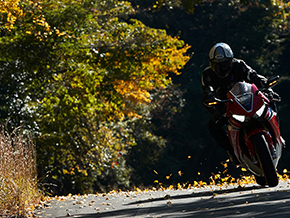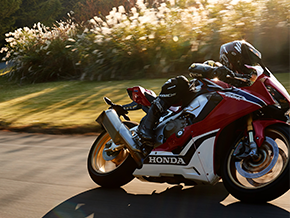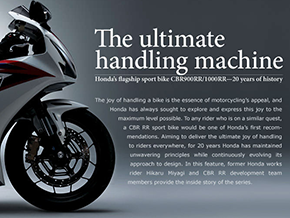Motorcycles Technology
CBR1000RR - Engineers Talk Part 2
The Future of the Super Sports Bike, Seen Through the CBR1000RR

For 25 years since its birth, the CBR-RR has been finely tuned, taking seriously what every rider, regardless of gender or skill, seeks in the joy of riding. In the world of racing, in MotoGP and other series, cutting edge electronic control technologies have been evolving. The CBR-RR meets electronic control, leading to the 2017 CBR1000RR.
The engine, brakes, suspension. Electronic control technologies allow these devices to share data with each other, adjust their characteristics according to the circumstances, and assist the rider. How did Honda’s engineers develop the all-new CBR1000RR to realize the joy of riding? How do they view the future of super sports, beyond the electronic control technologies?
The Successive CBR-RR Concept Intensifies Through Electronic Control
Hikaru Miyagi, Former Honda factory rider
Electronic Control, the new addition to the CBR-RR to bring the rider the joy of riding. What do the engineers think? How did they implement the technologies?
Electronic control uses a computer to realize operations not possible through conventional mechanisms. The engine, brakes and suspension seem to affect each other like never before. Were there major changes in development?
Yoshinori Korogi, Handling, stability, and riding comfort Control Engineer:
It’s true that by the addition of electronic control, there was a new process. On the other hand, one of the goals with CBR-RR development was the “joy of riding,” so we were all working across each other’s boundaries during development.
Mr. Iwaya, for example, designed the fuel injection and intake / exhaust system, but had requests for me about the bike’s handling.

Yoshinori Korogi, Handling, stability, and riding comfort Control Engineer

Yasunori Iwaya, Drivability Engineer
Miyagi
That’s a good thing.
Yasunori Iwaya, Drivability Engineer
My development area has a large effect on handling, so I work on development taking into account what the handling engineer has to say.
The development of each generation of CBR-RR has always been about coordination between the different development areas, and not just trying to maximize performance in our own fields alone, because our goal is to realize the rider’s “joy of riding.” So from my viewpoint, the addition of electronic controls did not really affect how we developed the CBR-RR.
Fuyuki Hosokawa, CBR1000RR Deputy Project Leader
There is a difficulty with electronic control, as the increase by more than tenfold in the number of components that affect each other means that any setting changes require adjusting every aspect, and we also applied every electronic control technology we had at the same time. I believe, however, that our team was tightly knit, allowing us to overcome any difficulties.
Miyagi
I have had a few rides on the new CBR1000RR, and the engine’s quality is amazing. The crisp straight-4 sound, practically giving the rider the feeling of each cylinder firing, is wonderful, and the smoothness from the low to high revs is brilliant. Its response not just in acceleration but deceleration is vastly superior to the previous models, and it is a well-built package overall.
Tell us about the new throttle-by-wire feature.
Iwaya
With the previous model, I took a lot of care in how easy the engine’s handling was. It was powerful, yet when opening the throttle slightly, the power could be easily controlled. I think I was successful in bringing out the same characteristics in the new CBR1000RR as well.
There is, however, a limit to what can be done with conventional methods, by controlling the throttle valve by a wire connected to the throttle grip. To build a bike that the rider could control and enjoy more enthusiastically, our solution was throttle-by-wire.

Fuyuki Hosokawa, CBR1000RR Deputy Project Leader

Throttle-by-wire System
Throttle valve is controlled by motor, rather than manually. In a conventional system, throttle operations are conveyed to the throttle valve via cable. With throttle-by-wire, the rider’s throttle operation is read from the position of the accelerator, and the signal is used by the ECU to control the throttle valve motor.
Miyagi
I see. A one-to-one correlation between the rider’s operation and the throttle valve does sound very attractive. Converting the rider’s operation to an electric signal and controlling the throttle valve by motor also means the engineers can design even more precise power characteristics. What does the rider gain?
Iwaya
Precision control of power delivery means a deep integration of better performance with higher throttle controllability. I believe we managed to evolve the CBR-RR’s vital characteristic, enabling any rider in any situation on any road surface to operate the throttle grip confidently.
CBR1000RR - Engineers Talk



